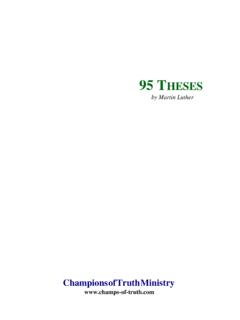Transcription of The phrase for this morning is Luther’s statem ”— [from ...
1 The sermon this morning is a continuation of a sermon series entitled, Here We Stand: Sure Faith in Uncertain Times. The series relates to the fact that this fall is the 500th anniversary of the moment when Martin luther nailed his 95 theses on the church door at Wittenberg, thus spurring the beginning of the Protestant Reformation; and so in this series we have been tracking key ideas of the Protestant Reformation in order to reflect about our own faith and how we can have a sure faith in very uncertain times. We have noted over the past weeks that each main concept of the Reformation can be summarized in a short Latin phrase . The phrase for this morning is luther s statement, Omnes sumus sacerdotes which means, we are all priests. [from The Babylonian Captivity of the Church, luther , 1520] This relates to that passage we heard a few moments ago from the first letter of Peter, which said, You are a royal priesthood.
2 (I Peter 2:9) The idea ultimately got expressed in the Reformation as the priesthood of all believers. You and I are priests. But what does that mean? Something quite important, which we will consider this morning . Let us begin with a moment of prayer .. In the field called the phenomenology of religion, which is the study of the nature and function of religion, scholars will often talk about archetypes. An archetype in religion is a basic pattern or form which has recurred since the dawn of time across all different religions. This is one of the reasons that scientists will sometimes say that human beings are hard wired for God because we seem to have a fundamental framework for religion built into us. One of the primary archetypes in religion is that of the priest. You find priests in all different religions. There were Mayan priests who ascended to the top of temple pyramids. There were Egyptian priests who presided over the rituals in Egyptian temples.
3 There are Shinto priests, Taoist priests, Zoroastrian priests, and Hindu priests. And of course there are priests in the Bible. Although various religions are in many ways very different, the function of the priest is quite similar, and can be summed up in three main points: 1) First, the priest is set apart. The priest is in some way separated from worldly activity in order to be devoted to the divine. Priests will often live apart from the rest of the population and may wear special garments, and may follow distinctive rules for living. 2) Secondly, the priest serves in ministry, carrying out sometimes routine functions in order to support the worship of the community or to help people in various life situations. Zoroastrian priests, for example, tend the fires that continually burn in Zoroastrian temples. Hindu priests guide people through rituals at key life moments such as the birth of a child.
4 3) Finally, the priest functions as mediator the most critical priestly function. This relates to a universal human perception that there is a distance or separation between humanity and God. The 2 Biblical word for that distance is sin. The role of the priest is to somehow bridge the gap between people and the divine. The priest as mediator represents the people and engages in some activity, often a sacrifice, that is designed to enable the people to connect afresh with God. Old Testament priests fulfilled exactly this pattern. The priests were set apart: they followed a distinctive set of rules, and wore special vestments when leading in worship. The priests carried out many functions to minister to the community; and the central priestly role was to serve as mediator, to enable a sinful people to enter into the presence of God, which the priests did by offering sacrifices. This mediating role was especially fulfilled by the high priest, and it came to a particular focus on one day of the year Yom Kippur, the day of atonement.
5 In the Jewish calendar this year, Yom Kippur was this weekend. It started Friday evening at sunset and just ended last night. In Old Testament days, the high priest on Yom Kippur would enter the Holy of Holies, the central place in the temple where it was thought that God especially dwelled, and which no one ever entered except the high priest on the day of atonement. The high priest entered as representative of all the people, and the high priest engaged in a sacred ritual to bring about atonement for the people forgiveness of their sins so that they could be accepted into the mercy of God. Thus the high priest was the mediator, through whom a sinful people could be reconciled with God. Because of the function of the priest in this way, in many cultures the priests came to be seen as being on a spiritual level that is higher than everyone else. But the Old Testament bursts that bubble immediately.
6 The first high priest in the history of Israel was Aaron, the brother of Moses, and the first story told about Aaron in his role as priest was one in which he messed up entirely it is the story of the golden calf, where Aaron leads the people to worship a statue, when they were supposed to be waiting for the ten commandments and worshiping God. Thus at the outset, the Old Testament makes plain that the priests are flawed; they are ordinary people who are no better than anyone else. The Old Testament is clear that the role of priest is a function it is the task of serving in ministry with the aim of helping people to connect with God it is not a spiritual status. But by the late Middle Ages, the setting of the Protestant Reformation, things in the church had gotten off kilter. The priests in the Catholic church were part of a hierarchy in which the ones higher in the hierarchy were considered spiritually superior to the ones lower.
7 The pope, cardinals, and bishops were at the top. A little below them were the priests, along with monks and nuns, and way down at the bottom were the laity the regular members of the church. The church taught that you are far too sinful to even think about approaching God directly. You need to go to a priest. You confess your sins to the priest, and the priest can then pronounce forgiveness, tell you what to do to make amends, and dispense God s grace to you through various sacraments. The parish priest was thus the mediator between the members of the church and God. 3 But the Reformers saw that this was a sharp departure from Biblical teaching especially the direction that the Bible takes in the New Testament. The New Testament says that there is no longer need for any human mediator such as the high priest in Old Testament days, because there is now one perfect Mediator, one ultimate high priest, and that is Christ.
8 Christ has joined himself with all humanity and now represents all of us. Christ has made the perfect and complete sacrifice on our behalf, by offering himself on the cross; thus the crucifixion is the ultimate and permanent day of atonement for all humanity. Christ has reconciled us with God. Thus Christ is our high priest; as the book of Hebrews put it, We now have a great high priest who has passed through the heavens, Jesus, the Son of God. (Hebrews 4:14) So, the Reformers proclaimed, you do not need to go through any human priest in order to approach God, and you do not need a priest to dispense God s grace to you. You can go directly to Christ, and you can experience the fullness of God s grace through Christ. You need no other mediator, because, as it is said in the passage we heard from I Timothy, There is one mediator between God and humankind, Christ Jesus, himself human, who gave himself as a ransom for all.
9 (I Timothy 2:5-6) This relates to our theme last week that we are saved through Christ alone. Today, many people in America have gotten this message that you can go directly to Christ; but what many people have concluded from this is that it means you do not need the church. You can just have your own private relationship with Jesus. But this really misses the New Testament message; because if Christ is the high priest, who are the priests? The priests are you and me all of us which means we are each now called to join with Christ in the ministry of the church in order to live out together the role of the priests. As Peter said to all believers, Come to Christ, a living stone, and like living stones, let yourselves be built into a spiritual house [that would be the church], to be a holy priesthood, to offer spiritual sacrifices acceptable to God through Jesus Christ. (I Peter 2:4-5) Consider again the three main functions of priests.
10 The mediating function, as we have seen, along with a perfect sacrifice made on our behalf, has now been essentially accomplished by Jesus Christ; but Peter says that we can all still share with Christ in this by offering our own spiritual sacrifices to God, that is, by committing ourselves to God s work; and we can share with Christ the Mediator in bridging the gap between humanity and God by telling others about the grace of Christ. A central role of priests is to serve in ministry; and the New Testament says a lot about how we can each now serve God in all sorts of different ministries, each of which is equally valuable. Being a preacher or pastor is just one kind of ministry. You can be a Sunday School teacher, a choir member, a sound or video volunteer, an usher, a helper with the Trash and Treasure Sale, and so forth. We all are called to be priests in that we can each do some kind of service for God.


